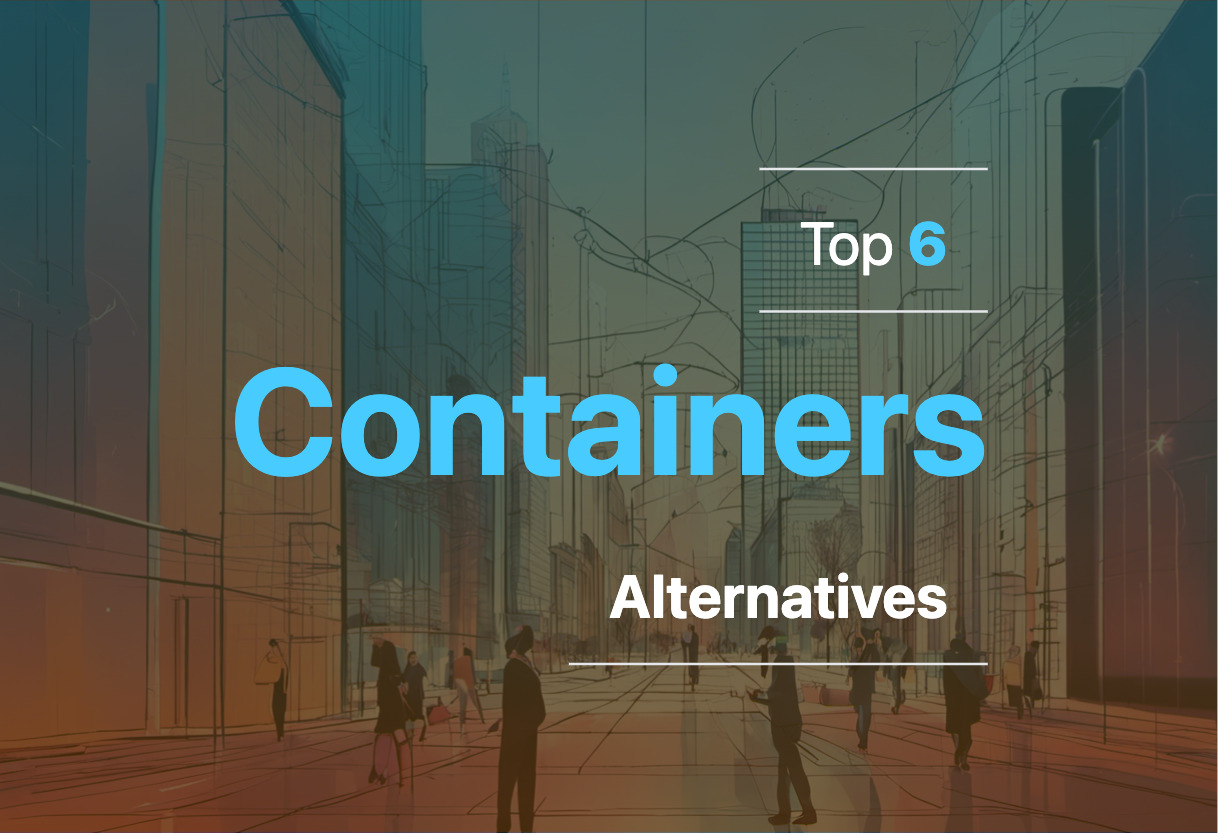Containers enhance software portability, consistency, and swift deployment by creating isolated environments for apps and their dependencies. Docker, an open platform, packages and runs applications in containers that are lightweight and secure. With Docker’s client-server architecture, managing the lifecycle of containers is efficient.

For those exploring options beyond Containers, alternatives include WASM, Ethereum Virtual Machine, Java Virtual Machine, ReactJS, JavaScript.
Docker

Founded in 2013, Docker stands as a trailblazer in the realm of container technology. This open-source initiative revolutionized the way we deploy applications, by encapsulating them and their dependencies into standardized units, readable and executable across diverse environments, from data centers to cloud providers. Docker’s platform creates a bridge between apps and infrastructure, optimizing performance, security and resource allocation.
Docker Top Features
- Lightweight Containers: Docker’s container images are standalone, lightweight, and executable software packages, leading to reduced server and licensing costs.
- Compatibility: Docker’s software can be reliably run on diverse computing environments, supporting both Linux and Windows-based applications.
- Consistent management: Docker allows infrastructure to be managed in the same manner as applications, thus enhancing software delivery speed.
- Security and resource allocation: Advanced container technology enhances security, boosts performance, and optimizes resource management and allocation.
| Feature | Benefit |
|---|---|
| Integration | Suits continuous integration and continuous delivery workflows |
| Portability | With containers, workloads become portable across mixed environments including physical and virtual machines, data centers, cloud providers. |
| Efficiency | Offers significant improvements over hypervisor-based virtual machines in terms of resource management and efficiency. |
Docker Limitations
- Proprietary nature: Despite Docker’s popularity, new runtime engines like containerd and CRI-O have increasingly replaced Docker’s runtime engine.
- Complexity: Docker’s user-friendly GUI contrasts with more complex aspects of the platform, which can be challenging for newcomers.
Docker Pricing
Docker is an open-source platform, making it free of charge but donations and contributions are welcome for continuous development.
Docker Use Cases
Use case 1: Continuous Integration/Continuous Delivery Workflows
Docker’s container technology makes it an ideal solution for continuous integration and continuous delivery workflows. It enhances speed and reliability in software delivery.
Use Case 2: Resource Management
In terms of resource efficiency, Docker trumps over hypervisor-based virtual machines. Its lightweight containers require less setup time, and tear down quickly, reducing management overhead.
Use Case 3: App Deployment Across Diverse Environments
For applications with a range of dependencies, Docker’s ability to encapsulate these into standardized units makes app deployment across diverse computing environments more reliable.
WASM
WebAssembly (WASM), a standard established by W3C in 2019, enhances web performance, offering new features and major performance gains. This innovative binary format engine runs seamlessly in all major browsers.
WASM Top Features
- Speed& Efficiency: WASM aims for high speed, efficiency, portability, and security, enabling code in multiple languages to run at near-native speed on the web.
- Interoperability: WASM’s design allows it to work alongside JavaScript, helping web developers create high-performance functions without needing specific app runtimes.
- Memory Management: The limited set of instructions coupled with improved memory management drastically reduces the vulnerability attack surface and prevents common issues like buffer overflows.
| Feature | Description |
|---|---|
| Language Compatibility | WASM supports an array of languages, including C, C++, Rust, Go, which can be compiled to WebAssembly. |
| Text Format Support | This feature allows easy debugging and code rewriting, enhancing the user experience. |
| Advanced Security | WASM improves application security by reducing the vulnerability attack surface, providing better memory safety, obscuring code, and sandboxing the environment. |
WASM Limitations
- Currently, WASM has a limited set of instructions, which may restrict functionality.
- While WASM provides better memory management, it may still demand more resources than traditional JavaScript.
WASM Pricing
WASM is an open standard and doesn’t have any associated cost. It is readily available for use by developers.
WASM Use Cases
Use case 1: AR/VR applications
WASM remarkably helps navigate performance bottlenecks in JavaScript for resource-intensive applications like AR and VR, offering a significant boost in user experience.
Use case 2: Scientific Simulations
With its near-native speed execution, WASM serves as a robust platform for running heavy-duty applications like scientific simulations.
Use case 3: Video Editing
WASM’s low-level operations and memory management capabilities allow developers to build powerful video editing applications with more efficiency and better performance.
Ethereum Virtual Machine
Immerse in the intricate world of Ethereum Virtual Machine (EVM) – a runtime environment breathing life into smart contracts on Ethereum.
Top Features of Ethereum Virtual Machine
- Provides home to all Ethereum accounts and smart contracts.
- Ensures uninterrupted and immutable operation of the state machine.
- Transacts flawlessly from block-to-block using predefined rules.
Turns a set of valid transactions (T) and an old valid state (S) into a new valid output state.Supports multiple standalone implementations including Py-EVM, evmone, and ethereumjs-vm.Built-in mechanism for managing ETH tokens and the state of blockchain.Powers blockchain, smart contracts and aids massively in decentralization.
| Contributions | Description |
|---|---|
| Turing Completeness | Allows running of programs written in a variety of languages. |
| Nature of Transactions | Two signed types of transactions are executed: message calls and contract creations. |
| Deterministic Processing | Offers the ability to execute complex smart contracts and ensures correct execution of transactions. |
Limitations of Ethereum Virtual Machine
- Requires technical expertise for smart contract creations.
- Bears high cost in maintaining data storage, attributed to high gas cost.
Ethereum Virtual Machine Use Cases
Use case 1: Deploying DApps
EVM paves the way for developers to pose as architects of Decentralized Applications (DApps) leveraging its smart contract functionalities.
Use case 2: Blockchain Decentralization
In the pursuit of decentralization, EVM’s potential comes handy in managing state, participating in block creation, and executing transactions.
Use case 3: Smart Contract Execution
With EVM, businesses can run untrusted code without risking data and execute complex smart contracts.
Java Virtual Machine
In the expansive world of web development, the Java Virtual Machine (JVM) stands as a paramount tool. A program in its own right, JVM has the unique ability to execute other programs, heralding a trend towards more portable and performant digital environments.
Java Virtual Machine Top Features
- JVM embodies the “write once, run anywhere” philosophy, allowing Java programs to run seamlessly across various devices and operating systems.
- It significantly improves performance through its deft handling of program memory and wide-ranging compatibility with languages other than Java.
- Utilizing an efficient system known as “Garbage Collection”, JVM automatically clears up unused memory, boosting the speed and responsiveness of Java programs.
- Execution engine of JVM stands between running program and OS, managing access to system resources and responsible for disposing of unused memory through garbage collection.
| Components of JVM | JVM consists of three main components: specification, implementation, and instance offering robustness and flexibility in its operations. |
| Support for Multiple Languages | Apart from Java, JVM supports a multitude of other programming languages maintaining access to the vast reservoir of Java libraries. |
| Future Optimizations | Plans on introducing virtual threads for improved coding idioms and performance are in the pipeline, affirming JVM’s relevance in the current and future development landscape. |
Java Virtual Machine Disadvantages
- JVM can throw a launcher error during launch if required components are missing.
- Allocation and maintenance of referential structure often taken for granted by developers is managed by the JVM, any mismanagement can lead to memory issues.
- An instance of JVM can die if no non-daemon threads are running or if the application calls the system.exit() method itself, leading to potential disruptions in program operation.
Java Virtual Machine Pricing
As an integral part of the open-source Java Development Kit (JDK), JVM is freely available to users. Its implementation can also be sourced from various providers, including open-source and proprietary offerings.
Java Virtual Machine Use Cases
Use case 1
For developers aiming to design applications that can seamlessly transition across different devices and operating systems, JVM is an ideal tool. Its “write once, run anywhere” principle ensures that Java programs remain functional irrespective of the platform they are accessed from.
Use case 2
JVM is critical in applications related to containerized development, especially when using technologies such as Docker and Kubernetes. Its capabilities in standard configuration, monitoring and management make it ideal for microservices architecture.
ReactJS

Imagine a tool that helps you create dynamic, interactive applications by offering a combination of JavaScript and HTML. This is precisely what ReactJS brings to the table. An open-source, component-based library, ReactJS is focused on improving UI/UX design for both web and mobile applications.
ReactJS Top Features
- JSX: A combination of HTML and JavaScript. JSX, through the Babel compiler, translates code into JavaScript code, simplifying the coding process and making it more understandable.
- Virtual DOM: Functions as an exact replica of the real DOM, and only updates the modified part, enhancing performance and speed.
- One-Way Data Binding: In React, data flows from parent components to child components. Properties in the child component cannot return data to the parent component, but they can request data modification.
- React Extensions: It provides support for full-fledged UI applications, mobile app development, and server-side rendering.
- React Community: It’s not just a tool, but a community supported by Facebook and adopted by top companies like Netflix and Instagram.
| Feature | Description |
|---|---|
| Conditional Statements | JSX allows conditional statements making it possible to display data based on specific conditions. |
| Virtual Document Object Model (VDOM) | A light version of the real DOM, offering optimized updates for enhanced performance. |
| React State and Props | State is the origin of data that is changeable and triggers component re-rendering. Props are read-only components influencing render output. |
ReactJS Limitations
- Learning Curve: Despite its simplicity, newcomers to ReactJS may encounter a steep learning curve due to its comprehensive ecosystem and coding style.
- Documentation: In some aspects, ReactJS documentation might not always be up-to-date or comprehensive due to the rapid pace of development and update.
ReactJS Pricing
ReactJS is generously offered as an open-source library, meaning it’s available free of charge for developers worldwide.
ReactJS Use Cases
Improve UI/UX Design
ReactJS has been instrumental for companies, like Netflix and Instagram, in improving their UI/UX designs by creating more interactive applications.
Mobile App Development
With its mobile app development support, companies can build top-tier mobile applications using ReactJS.
Server-Side Rendering
SEO-friendly web applications can leverage ReactJS for server-side rendering, enhancing both application performance and search visibility.
JavaScript
JavaScript, a dynamic computer programming language, has proven itself as a cornerstone of web development since its inception in 1995. Originally named LiveScript, it later adopted the moniker JavaScript, reflecting the prevalent enthusiasm of that era for Java.
JavaScript Top Features
- Web Interactivity: With JavaScript, you can breathe life into static web pages by introducing interactivity and dynamic changes.
- Client-side Scripting: Empowers developers to interact directly with the user, providing immediate feedback and reducing server interaction.
- Object-oriented Capabilities: JavaScript’s support for object-oriented programming promotes code organization, modularity, and reuse.
- Network-centric Application Creation: Designed for creating network-centric applications, enhancing real-time communication on the web.
| Tool | Usage |
|---|---|
| Microsoft FrontPage, Macromedia Dreamweaver MX, Macromedia HomeSite 5 | Commonly used in the design and development of JavaScript-based web pages. |
| Node.js | Enables JavaScript to be used outside the browser context, extending its capability to server-side programming. |
| AJAX | With AJAX, JavaScript enables web pages to feel more reactive and native. |
JavaScript Limitations
- Limited Features: For security reasons, JavaScript lacks features like reading/writing files and networking applications.
- Absence of Multi-threading/Multiprocessor Capabilities: This limitation restricts JavaScript’s ability to execute multiple threads or processes parallelly.
JavaScript Use Cases
Use Case 1: Web Content Development
Creating HTML content and controlling browsers are easily accomplished with JavaScript, making it dependable for web content developers.
Use Case 2: UX/UI Development
JavaScript’s features empower UX/UI developers to deliver smooth and immediate feedback, enhancing user experience on websites.
Use Case 3: Server-side Programming
Thanks to Node.js, JavaScript is a valid tool for server-side programming, broadening the horizon of possibilities for web developers.
Grant Sullivan
Content writer @ Aircada and self proclaimed board game strategist by day, AI developer by night.





